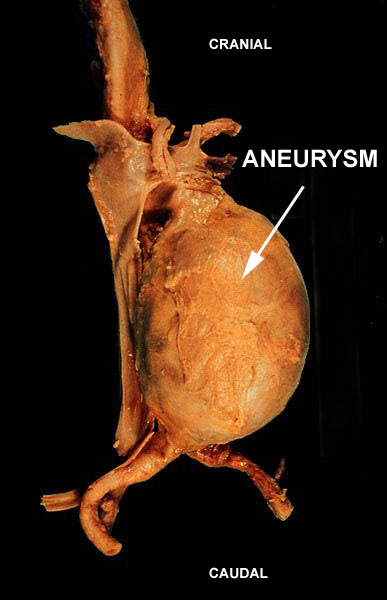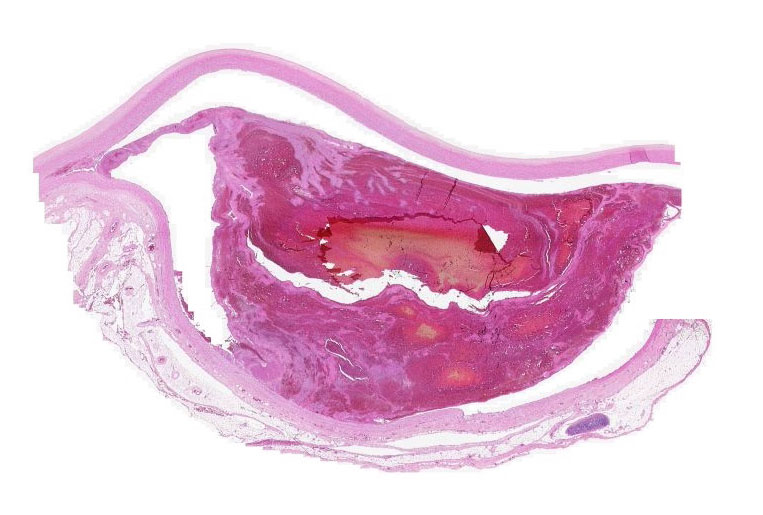DISCUSSION

 An aneurysm is a localized dilation or outpouching in the wall of an artery, cause by weakness at that point. Aneurysms can can do occur in any artery, but they are most commonly found in those that have to handle a great deal of internal pressure. Arteries are designed to resist pressure from the inside. they have walls that are strongly reinforced with multiple layers of connective tissue and/or smooth muscle: the CT is a mixture of collagen for strength and elastin for resilience. The proportions of these two components (and of the smooth muscle) vary from place to place, depending on the role the artery plays in the circulation.
An aneurysm is a localized dilation or outpouching in the wall of an artery, cause by weakness at that point. Aneurysms can can do occur in any artery, but they are most commonly found in those that have to handle a great deal of internal pressure. Arteries are designed to resist pressure from the inside. they have walls that are strongly reinforced with multiple layers of connective tissue and/or smooth muscle: the CT is a mixture of collagen for strength and elastin for resilience. The proportions of these two components (and of the smooth muscle) vary from place to place, depending on the role the artery plays in the circulation.
Arteries closes to the heart—the aorta and the pulmonary artery, for example—have to withstand very high levels: the aorta carries the entire head of pressure generated by the left ventricle, so as with other elastic or conducting arteries the wall of the aorta is heavily reinforced with numerous layers of elastic CT, in between which are found collagen fibers and smooth muscle.
The mechanical events that take place in the development of an aneurysm involve leakage of blood past the tunica intima and into the spaces separating the layers of the wall. Blood forced in under maximum pressure dissects the layers apart. As the wall weakens continuing infiltration makes the structure balloon even more, and sometimes a rupture occurs. A ruptured aneurysm in a major vessel, such as the aorta, is fatal within a very short time and not much can be done.
 The image shown above is of an aortic aneurysm, with a huge thrombus (i.e., a clot) associated with it. The damage to the wall causes roughening of the slick intima and localized turbulence;this in turn is responsible for the formation of clots. these can break off emboli which move in the bloodstream and may perhaps lodge in another vessel, causing an infarction, possibly a fatal one. At the point of invasion of the wall (left) blood is seeping under the tunica intima and separating the layers of CT by mechanical force. relatively recent regions of damage are visible as places in which erythrocytes are found intact; in older areas the erythrocytes have lysed and are forming clots. As a comparison to the images above, here's one of the wall as it's supposed to look:
The image shown above is of an aortic aneurysm, with a huge thrombus (i.e., a clot) associated with it. The damage to the wall causes roughening of the slick intima and localized turbulence;this in turn is responsible for the formation of clots. these can break off emboli which move in the bloodstream and may perhaps lodge in another vessel, causing an infarction, possibly a fatal one. At the point of invasion of the wall (left) blood is seeping under the tunica intima and separating the layers of CT by mechanical force. relatively recent regions of damage are visible as places in which erythrocytes are found intact; in older areas the erythrocytes have lysed and are forming clots. As a comparison to the images above, here's one of the wall as it's supposed to look:
 A lot of things can cause aneurysms, some of them genetic, some of them environmental, some of them unknown. In pigs (and some other species) very frequently the cause is a deficiency of copper in the diet. An analysis of the soil in this location might show either a low level of copper (primary deficiency) or a high level of molybdenum. Molybdenum interferes with copper absorption and causes a secondary deficiency. In either case, however, since copper is needed for proper CT synthesis, the wall isn't maintained and becomes susceptible to forming an aneurysm. In other cases events may be initiated by a parasite: stongyles in horses can cause damage to the tunica intima and subsequent aneurysm formation. Something similar can happen in dogs.
A lot of things can cause aneurysms, some of them genetic, some of them environmental, some of them unknown. In pigs (and some other species) very frequently the cause is a deficiency of copper in the diet. An analysis of the soil in this location might show either a low level of copper (primary deficiency) or a high level of molybdenum. Molybdenum interferes with copper absorption and causes a secondary deficiency. In either case, however, since copper is needed for proper CT synthesis, the wall isn't maintained and becomes susceptible to forming an aneurysm. In other cases events may be initiated by a parasite: stongyles in horses can cause damage to the tunica intima and subsequent aneurysm formation. Something similar can happen in dogs.
Aneurysms can result from a fall which weakens the wall mechanically, or by severe impact. In many cases, the cause is listed as "idiopathic," which is a fancy term for "I have no idea."
The clinical presentation of an aneurysm can be that of an ischemic episode, or the only "presentation" may be sudden death if the wall is weakened enough: That's what happened to this pig: he "blew out" and bled to death internally. If this case resulted from a deficiency of copper, mineral supplementation would prevent subsequent cases.

 An aneurysm is a localized dilation or outpouching in the wall of an artery, cause by weakness at that point. Aneurysms can can do occur in any artery, but they are most commonly found in those that have to handle a great deal of internal pressure. Arteries are designed to resist pressure from the inside. they have walls that are strongly reinforced with multiple layers of connective tissue and/or smooth muscle: the CT is a mixture of collagen for strength and elastin for resilience. The proportions of these two components (and of the smooth muscle) vary from place to place, depending on the role the artery plays in the circulation.
An aneurysm is a localized dilation or outpouching in the wall of an artery, cause by weakness at that point. Aneurysms can can do occur in any artery, but they are most commonly found in those that have to handle a great deal of internal pressure. Arteries are designed to resist pressure from the inside. they have walls that are strongly reinforced with multiple layers of connective tissue and/or smooth muscle: the CT is a mixture of collagen for strength and elastin for resilience. The proportions of these two components (and of the smooth muscle) vary from place to place, depending on the role the artery plays in the circulation.